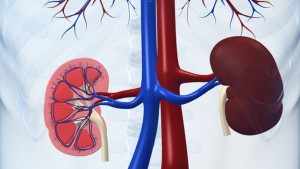Yokoo and his team who have found a way to grow a full-sized kidney using stem cells.
The American Cancer Society estimates there will be 61,000 new cases of kidney cancer in the United States this year. About 14,000 Americans will die from the disease in 2015. Kidney cancer is rare in people under the age of 45. The average age in the United States for diagnosis is 64. Still, there are more than 100,000 people in the United States awaiting kidney transplants, according to the National Kidney Foundation. The median wait-time is 3.6 years. With the number of patients with end-stage kidney failure increasing globally due to a limited supply of donor organs, this breakthrough is promising.
Scientists say they are a step closer to growing fully functioning replacement kidneys after a breakthrough in results in animals. They used rats as the incubators for the growing embryonic tissue. The kidneys were generated from stem cells and were first tested in pigs.
The researchers recently succeeded in growing functional kidneys from human stem cells, but these kidneys are unable to grow to full size because they have no pathway for excreting urine, resulting in a condition called hydronephrosis.
To solve this issue, Takashi Yokoo and fellow Jikei University School of Medicine researchers added a drainage pathway and compatible bladder to connect everything to the animal’s existing bladder, a technique they call ‘Stepwise peristaltic ureter’ or SWPU system.
The SWPU system may resolve two important problems in the generation of kidneys from stem cells. The construction of a urine excretion pathway, and continued growth of the newly generated kidney. Takashi Yokoo and colleagues developed a potential solution to this problem by implanting embryonic rat kidneys with bladders into adult rat hosts.
Four weeks after transplantation, the authors connected one of the host rat’s ureters to the transplanted bladder. This approach allowed the urine from the transplanted kidneys to pass into the transplanted bladder and then into the host bladder, thereby avoiding hydronephrosis. Eight weeks after transplantation, the kidney tissues contained structures characteristic of mature kidneys. When they connected up the new kidney and its plumbing to the animal’s existing bladder, the system worked.
Urine passed from the transplanted kidney into the transplanted bladder and then into the rat bladder.
To test the clinical feasibility of this system, called the stepwise peristaltic ureter (SWPU) system, they repeated the experiments using pigs and achieved results similar to those observed in rats.
This is an interesting step forward as the science looks strong and they have good data in animals but it may not work on humans as yet. Yokoo is pleased with his team’s results. He is optimistic about the possibilities going forwardand is already onto the next step of the process. “We already started the next stage to show that this system can be used in primates, using marmosets for the application to human,” he said.
The hope for Yokoo and the Jikei University team is to complete the experiments within the next 10 years.
Although still years off human trials, the research helps guide the way towards the end goal of making organs for people.
For more information please visit: www.jikei.ac.jp/eng


Comments are closed.